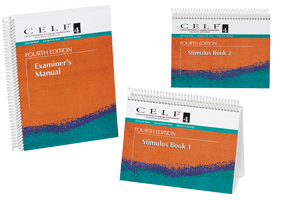Quickly and accurately identify and diagnose language disorders. CELF-5 now available
Clinical Evaluation of Language Fundamentals - Fourth Edition
CELF - 4
Quickly and accurately identify and diagnose language disorders. CELF-5 now availableChoose from our formats
Formulaires & rapports d'essai
Livrets, formulaires d'enregistrement, livrets de réponse, rapports d'utilisation et abonnements
3 options